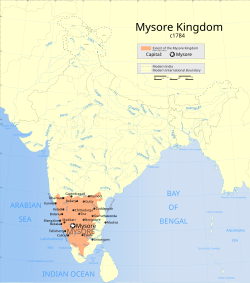Mysore Princely State
| Kingdom of Mysore Princely State of Mysore |
||||||||||
| Kingdom (Subordinate to Vijayanagara Empire until 1565) Princely state under the suzerainty of the British Crown from 1799 |
||||||||||
|
||||||||||
|
Anthem Kayou Sri Gowri |
||||||||||
|
Kingdom of Mysore, 1784 AD (at its greatest extent)
|
||||||||||
| Capital | Mysore, Srirangapatna | |||||||||
| Languages | Kannada | |||||||||
| Religion | Hinduism, Islam | |||||||||
| Government | Monarchy until 1799, Principality thereafter | |||||||||
| Maharaja | ||||||||||
| • | 1399–1423 (first) | Yaduraya Wodeyar | ||||||||
| • | 1940–50 (last) | Jayachamaraja Wodeyar | ||||||||
| History | ||||||||||
| • | Established | 1399 | ||||||||
| • | Earliest records | 1551 | ||||||||
| • | Disestablished | 1950 | ||||||||
|
||||||||||
| Today part of | Republic of India | |||||||||
The Kingdom of Mysore was a kingdom in southern India, traditionally believed to have been founded in 1399 in the vicinity of the modern city of Mysore. The kingdom, which was ruled by the Wodeyar family, initially served as a vassal state of the Vijayanagara Empire. With the decline of the Vijayanagara Empire (c. 1565), the kingdom became independent. The 17th century saw a steady expansion of its territory and during the rule of Narasaraja Wodeyar I and Chikka Devaraja Wodeyar, the kingdom annexed large expanses of what is now southern Karnataka and parts of Tamil Nadu to become a powerful state in the southern Deccan.
The kingdom reached the height of its military power and dominion in the latter half of the 18th century under the de facto ruler Haider Ali and his son Tipu Sultan. During this time, it came into conflict with the Marathas, the Nizam of Hyderabad, the Kingdom of Travancore and the British which culminated in the four Anglo-Mysore Wars. Success in the first two Anglo-Mysore wars was followed by defeat in the third and fourth. Following Tipu's death in the fourth war of 1799, large parts of his kingdom were annexed by the British, which signalled the end of a period of Mysorean hegemony over southern Deccan. The British restored the Wodeyars to their throne by way of a subsidiary alliance and the diminished Mysore was transformed into a princely state. The Wodeyars continued to rule the state until Indian independence in 1947, when Mysore acceded to the Union of India.
...
Wikipedia



